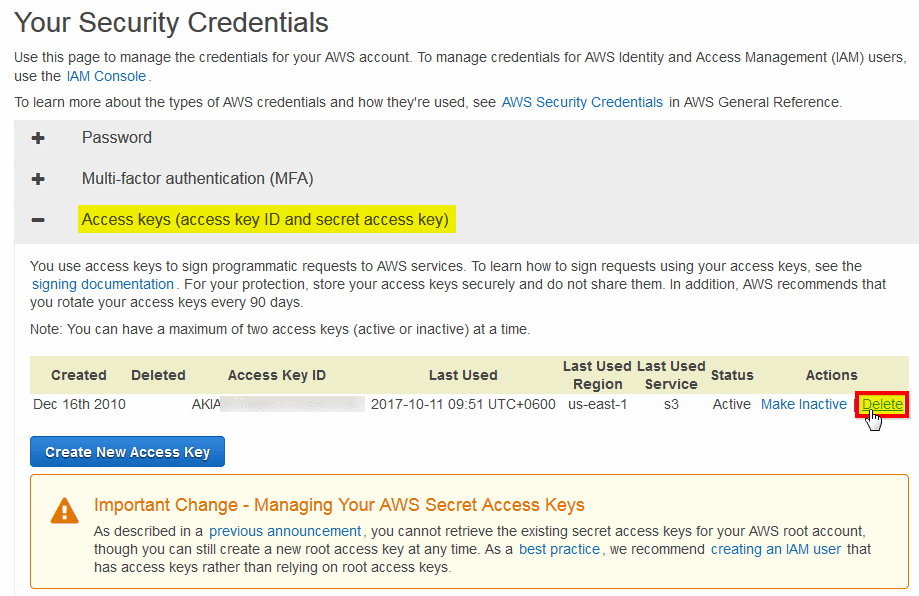Aws Generate Access Key For User
Jump into the IAM console and find the user you want to create the access key for. Next, you’ll click the “security credentials” tab and then click the “create access key” button. I recommend downloading these credentials; AWS provides you with a CSV file that details the access key and secret key. AWS: Allows IAM Users to Manage Their Own Password, Access Keys, and SSH Public Keys on the My Security Credentials Page This example shows how you might create a policy that allows IAM users to manage their own password, access keys, and X.509 certificates on the My Security Credentials page.
To get the access key ID and secret access key for an AWS Identity and Access Management (IAM) user, you can configure AWS CLI, or get temporary credentials for federated users to access AWS CLI. Before you can give access to a federated user, you must: Enable federation to AWS using Windows Active Directory, ADFS, and SAML 2.0. The AWS access keys are required for configuring our extensions in order to connect your WordPress website to Amazon S3 service. In this article, we will walk you through the following steps to create a new Amazon S3 bucket and get user access keys as quickly as possible. Creates a new AWS secret access key and corresponding AWS access key ID for the specified user. The default status for new keys is Active. If you do not specify a user name, IAM determines the user name implicitly based on the AWS access key ID signing the request. If your goal is to generate IAM access keys for a new user, login to the AWS console, go to IAM, go to users, Add User, click 'Programmatic access', then Set permissions for the user and finish by creating the user. On the next screen will be the access keys. You need to download (or copy) the Secret access key as it will NOT be shown again. Create a key pair for the new user account. Create a key pair, or use an existing one, for the new user.; If you create your own key pair using the command line, follow the recommendations at create-key-pair or New-EC2KeyPair Cmdlet for key type and bit length.; If you create your own key pair using a third-party tool, be sure that your key matches the guidelines at Importing Your Own Public.
Sep 24, 2019 Create CNAME DKIM DNS Records Login to the panel used to manage your domain names DNS records – this will often be either your domain name registrar such as 123-Reg and GoDaddy or it could be your website hosting account (a cPanel, Plesk or CloudFlare account). The Key Data will be a very long string of Base64 encoded bits. Mail.domainkey TXT v=DKIM1; k=rsa; p=Key Data Here Once this is entered, you'l want to want to wait a bit for the DNS system to catch up. Trusted Hosts. Create a file of hosts that DKIM should trust, one per line and comments are allowed. Here are example contents for our domain. Generate a DKIM Core Key. Enter the domain you'd like to generate keys for, for example dkimcore.org and hit the button. This online wizard is fine for generating keys for testing and evaluation. If you decide to use DKIM Core in production, though, you might want to consider the security risks. Generate domain key dkim edoceo.
Root Access Keys provide unlimited access to your AWS resources. It's not recommended to use them in normal situations. AWS recommends to delete existing Root Access Keys and create IAM user and Access Keys limited to specific service or resource (see below).
To Delete Root Access Keys
Aws Create Access Key For User
1. Type https://aws.amazon.com/ in your web browser
2. Click My Account, AWS Management Console
3. Enter your account email address and password:
4. Type the IAM in the search box and choose the IAM service from the drop-down list.
You will be redirected to IAM Dashboard

5. Navigate to Security Status and expand the Delete your root access keys section.
Get Aws Access Key

6. Click Manage Security Credentials
7. Click Continue to Security Credentials
Your Security Credentials page will open
8. Expand the Access Keys (access key id and secret acces key) section
9. Click the Delete link next to your access keys row.
10. Confirm Access Keys deletion.
11. Your Root Access Keys are deleted. Now you can create IAM user and Access Keys limited to specific service or resource (see below).
Be sure to replace your root access keys with your IAM access keys in any programs/scripts you are currently using.